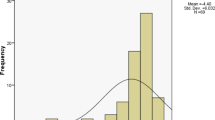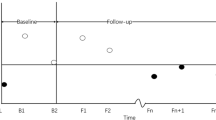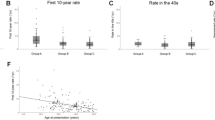Abstract
Purpose
To compare progression of primary open angle glaucoma (POAG) in asymmetrically myopic eyes within the same subject and evaluate whether the degree of myopia is related to glaucoma progression.
Methods
POAG patients with asymmetric myopia (axial length [AXL] ≥24 mm in both eyes, and the AXL difference between the right and left eyes to be ≥0.5 mm) were included. Glaucoma progression was determined either by optic disc/retinal nerve fiber layer (RNFL) photographs or by serial visual field (VF) data. The progression rates of VF mean deviation (dB/year) and spectral domain optical coherence tomography measured RNFL thickness (μm/year) were compared between the more myopic eye (MME) and the less myopic eye (LME) within the same subject.
Results
A total of 55 patients (mean follow up period; 4.5 ± 1.0 years) were included. The mean AXL demonstrated a significant difference between MME and LME (26.3 ± 1.7 vs. 25.6 ± 1.7 mm; p = 0.036). The mean baseline VF MD (−3.8 ± 5.4 vs. −2.6 ± 4.7 dB; p = 0.21) and average RNFL thickness (77.5 ± 10.6 vs. 79.9 ± 12.3 μm; p = 0.36) did not differ between the MME and LME. Among the 55 patients, optic disc/RNFL photographic progression was noted in the MME in 15 patients, in the LME in 19 patients, and in both eyes in seven patients. VF progression was noted in the MME in seven patients, in the LME in seven patients, and in both eyes in four patients. The VF MD progression rates were −0.25 ± 0.34 dB/year in MME and −0.26 ± 0.34 dB/year in LME cases (p = 0.91). The mean progression rate of the average RNFL thickness also did not differ between the MME and LME (−0.59 ± 0.67 vs. -0.66 ± 0.72 μm/year, p = 0.68).
Conclusions
The degree of myopia was not associated with glaucoma progression when assessing the same patient using either the VF or optic disc/RNFL criteria in asymmetrically myopic patients.



Similar content being viewed by others
References
Marcus MW, de Vries MM, Junoy Montolio FG, Jansonius NM (2011) Myopia as a risk factor for open-angle glaucoma: a systematic review and meta-analysis. Ophthalmology 118:1989–1994
Xu L, Wang Y, Wang S et al (2007) High myopia and glaucoma susceptibility the Beijing eye study. Ophthalmology 114:216–220
Casson RJ, Gupta A, Newland HS et al (2007) Risk factors for primary open-angle glaucoma in a Burmese population: the Meiktila eye study. Clin Experiment Ophthalmol 35:739–744
Kuzin AA, Varma R, Reddy HS et al (2010) Ocular biometry and open-angle glaucoma: the Los Angeles Latino eye study. Ophthalmology 117:1713–1719
Perera SA, Wong TY, Tay WT et al (2010) Refractive error, axial dimensions, and primary open-angle glaucoma: the Singapore Malay eye study. Arch Ophthalmol 128:900–905
Mitchell P, Hourihan F, Sandbach J, Wang JJ (1999) The relationship between glaucoma and myopia: the Blue Mountains eye study. Ophthalmology 106:2010–2015
Kim YJ, Yun SC, Na JH et al (2012) Glaucoma progression in eyes with a history of refractive corneal surgery. Invest Ophthalmol Vis Sci 53:4485–4489
Lee JY, Sung KR, Han S, Na JH (2015) Effect of myopia on the progression of primary open-angle glaucoma. Invest Ophthalmol Vis Sci 56:1775–1781
Bengtsson B, Heijl A (2005) A long-term prospective study of risk factors for glaucomatous visual field loss in patients with ocular hypertension. J Glaucoma 14:135–138
Heijl A, Leske MC, Bengtsson B et al (2002) Reduction of intraocular pressure and glaucoma progression: results from the early manifest glaucoma trial. Arch Ophthalmol 120:1268–1279
Sung KR, Lee S, Park SB et al (2009) Twenty-four hour ocular perfusion pressure fluctuation and risk of normal-tension glaucoma progression. Invest Ophthalmol Vis Sci 50:5266–5274
Sohn SW, Song JS, Kee C (2010) Influence of the extent of myopia on the progression of normal-tension glaucoma. Am J Ophthalmol 149:831–838
Araie M, Shirato S, Yamazaki Y et al (2012) Risk factors for progression of normal-tension glaucoma under beta-blocker monotherapy. Acta Ophthalmol 90:e337–e343
Chihara E, Liu X, Dong J et al (1997) Severe myopia as a risk factor for progressive visual field loss in primary open-angle glaucoma. Ophthalmologica 211:66–71
Doshi A, Kreidl KO, Lombardi L et al (2007) Nonprogressive glaucomatous cupping and visual field abnormalities in young Chinese males. Ophthalmology 114:472–479
Heijl A, Leske MC, Bengtsson B et al (2003) Measuring visual field progression in the early manifest glaucoma trial. Acta Ophthalmol Scand 81:286–293
Vongphanit J, Mitchell P, Wang JJ (2002) Population prevalence of tilted optic disks and the relationship of this sign to refractive error. Am J Ophthalmol 133:679–685
Tay E, Seah SK, Chan S-P et al (2005) Optic disk ovality as an index of tilt and its relationship to myopia and perimetry. Am J Ophthalmol 139:247–252
Lee EJ, Kim T-W, Weinreb RN et al (2011) β -zone parapapillary atrophy and the rate of retinal nerve fiber layer thinning in glaucoma. Invest Ophthalmol Vis Sci 52:4422–4427
Park SB, Sung KR, Kang SY et al (2009) Comparison of glaucoma diagnostic capabilities of Cirrus HD and stratus optical coherence tomography. Arch Ophthalmol 127:1603–1609
Sung KR, Kim DY, Park SB, Kook MS (2009) Comparison of retinal nerve fiber layer thickness measured by Cirrus HD and stratus optical coherence tomography. Ophthalmology 116:1264–1270
Lee JH, Jee D, Kwon J-W, Lee WK (2013) Prevalence and risk factors for myopia in a rural Korean population prevalence and risk factors for myopia. Invest Ophthalmol Vis Sci 54:5466–5471
Yoon K-C, Mun G-H, Kim S-D et al (2011) Prevalence of eye diseases in South Korea: data from the Korea national health and nutrition examination survey 2008–2009. Korean J Ophthalmol 25:421–433
Jung S-K, Lee JH, Kakizaki H, Jee D (2012) Prevalence of Myopia and its association with body stature and educational level in 19-year-old male conscripts in Seoul, South Korea prevalence on myopia in young males in Korea. Invest Ophthalmol Vis Sci 53:5579–5583
Klein BE, Klein R, Sponsel WE et al (1992) Prevalence of glaucoma: the Beaver Dam eye study. Ophthalmology 99:1499–1504
Chon B, Qiu M, Lin SC (2013) Myopia and glaucoma in the South Korean population. Invest Ophthalmol Vis Sci 54:6570–6577
Hung K-H, Cheng C-Y, Liu CJ-L (2014) Risk factors for predicting visual field progression in Chinese patients with primary open-angle glaucoma: a retrospective study. J Chin Med Assoc 78:418–423
Jonas JB, Martus P, Budde WM (2002) Anisometropia and degree of optic nerve damage in chronic open-angle glaucoma. Am J Ophthalmol 134:547–551
Park HY, Lee KI, Lee K, Shin HY, Park CK (2014) Torsion of the optic nerve head is a prominent feature of normal-tension glaucoma. Invest Ophthalmol Vis Sci 56:156–163
Leung CK, Choi N, Weinreb RN et al (2010) Retinal nerve fiber layer imaging with spectral-domain optical coherence tomography: pattern of RNFL defects in glaucoma. Ophthalmology 117:2337–2344
Tomita G, Araie M, Kitazawa Y, Tsukahara S (2004) A three-year prospective, randomized and open comparison between latanoprost and timolol in Japanese normal-tension glaucoma patients. Eye 18:984–989
Araie M, Shirato S, Yamazaki Y et al (2008) Clinical efficacy of topical nipradilol and timolol on visual field performance in normal-tension glaucoma: a multicenter, randomized, double-masked comparative study. Jpn J Ophthalmol 52:255–264
Na JH, Sung KR, Baek SH et al (2015) Rates and patterns of macular and circumpapillary retinal nerve fiber layer thinning in preperimetric and perimetric glaucomatous eyes. J Glaucoma 24:278–285
Na JH, Sung KR, Lee JR et al (2013) Detection of glaucomatous progression by spectral-domain optical coherence tomography. Ophthalmology 120:1388–1395
Kostanyan T, Sung KR, Schuman JS et al (2016) Glaucoma structural and functional progression in American and Korean Cohorts. Ophthalmology
Lee JY, Sung KR, Yun SC (2015) Comparison of rates of retinal nerve fibre layer thinning between patients with non-myopic and myopic glaucoma. Br J Ophthalmol. doi:10.1136/bjophthalmol-2015-307343
Author information
Authors and Affiliations
Corresponding author
Ethics declarations
Funding
This study was supported by a grant (2014–500) from the Asan Institute for Life Sciences, Asan Medical Center, Seoul, Korea, Student Research Grant (2015) of University of Ulsan College of Medicine, Seoul, Korea, and the Basic Science Research Program through the National Research Foundation of Korea (NRF), which is funded by the Ministry of Education, Science, and Technology (NRF-2014R1A1A3A04051089). The sponsor had no role in the design or conduct of this research.
Conflict of interest
None of the authors have any affiliations with or involvement in any organization or entity with any financial interest (such as honoraria; educational grants; participation in speakers’ bureaus; membership, employment, consultancies, stock ownership, or other equity interest; and expert testimony or patent-licensing arrangements), or non-financial interest (such as personal or professional relationships, affiliations, knowledge, or beliefs) in the subject matter or materials discussed in this manuscript.
Ethical approval
All procedures performed in studies involving human participants were in accordance with the ethical standards of the institutional and/or national research committee and with the 1964 Helsinki declaration and its later amendments or comparable ethical standards. For this type of study formal consent is not required.
Financial disclosure
None.
Rights and permissions
About this article
Cite this article
Song, M.K., Sung, K.R., Han, S. et al. Progression of primary open angle glaucoma in asymmetrically myopic eyes. Graefes Arch Clin Exp Ophthalmol 254, 1331–1337 (2016). https://doi.org/10.1007/s00417-016-3332-z
Received:
Revised:
Accepted:
Published:
Issue Date:
DOI: https://doi.org/10.1007/s00417-016-3332-z




